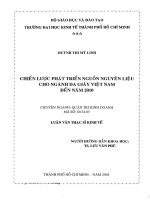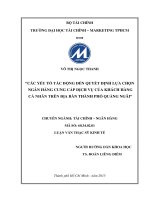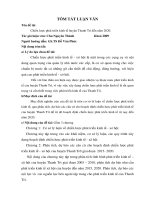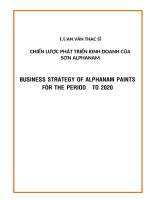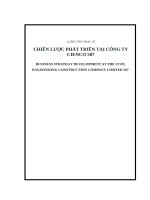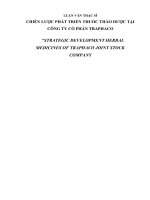LUẬN văn THẠC sĩ CHIẾN lược PHÁT TRIỂN KINH DOANH của sơn ALPHANAM
Bạn đang xem bản rút gọn của tài liệu. Xem và tải ngay bản đầy đủ của tài liệu tại đây (1.46 MB, 61 trang )
LUẬN VĂN THẠC SĨ
CHIẾN LƯỢC PHÁT TRIỂN KINH DOANH CỦA
SƠN ALPHANAM
BUSINESS STRATEGY OF
ALPHANAM PAINTS FOR THE
PERIOD TO 2020
ACKNOWLEDGEMENT
First of all, we would like to express our sincere thanks to Griggs University and
all members of ETC who created an excellent program that is a useful education.
We also would like to express our thanks to the people who has helped and
supported us during completion of this report, especially to ALPHA NAM’s
leaders and business department of paints who freely and warmly provided us the
trust information of company.
Finally, we would like to commit that, the capstone project report stated below had
been honestly completed by all of our group’s members.
Hanoi, October 2009
Members of Group No. 5
Bui Hoang Tuan
Hoang Thi Minh Thuy
GAMBA.M01- Group 5: Capstone Project
Nguyen Van Hung Le Van Duc
Page - 2
TABLE OF CONTENTS
INTRODUCTION...................................................................................................................5
1. Rationales
5
2. Objectives of research.........................................................................................................6
3. Limitation and methodology of research.........................................................................6
4. Significance of the research...............................................................................................7
5. Report structure..................................................................................................................7
CHAPTER 1: THEORETICAL BASIC OF BUSINESS STRATEGY...........................8
1.1. OVERVIEW...............................................................................................................8
1.1.1. Definitions of strategy.........................................................................................8
1.1.2. Strategic management processes.........................................................................9
1.2 ENVIRONMENTAL ANALYSIS.............................................................................11
1.2.1. External environment analysis..........................................................................11
1.2.2 Internal environment analysis............................................................................15
1.3. SWOT ANALYSIS...................................................................................................23
1.4. DECISION OF STRATEGIES.................................................................................25
CHAPTER 2: ACTUAL SITUATION ANALYSIS OF ALPHANAM PAINTS..........26
2.1. INTRODUCTION....................................................................................................26
2.1.1. General information of company......................................................................26
Organizational structure..............................................................................................28
2.1.2. Alphanam paints................................................................................................31
......................................................................................................................................31
2.2. ACTUAL SITUATION ANALYSIS........................................................................34
2.2.1. Macro environment analysis.............................................................................34
2.2.2. Industry environment analysis...........................................................................39
2.2.3. Competitor environment analysis......................................................................44
LIST OF REFERENCES.....................................................................................................63
Table 2.2.a: Market size and Players on decorative paints..........................................46
2.2.4. Internal environment analysis...........................................................................47
2.3. PART CONCLUSION..............................................................................................49
CHAPTER 3: DECISION ON BUSINESS STRATEGY AND
RECOMMENDATIONS FOR THE PERIOD 2010 TO 2015.........................................50
3.1. SWOT ANALYSIS...................................................................................................50
3.2. COMBINATION STRATEGIES.............................................................................50
3.2. RECOMMENDATIONS FOR THE PERIOD 2010 TO 2015.................................52
3.2.1. Actual market analysis.......................................................................................52
3.2.2. Redefine the target and strategies:.....................................................................57
3.2.3. Corporate-level strategies:.................................................................................60
CONCLUSION 62
GAMBA.M01- Group 5: Capstone Project
Page - 3
LIST OF ABBREVIATIONS
Abbreviations
AFTA
ASEAN
APEC
ASEM
CEPT
CPI
GDP
GREAT
JSC
PEST
SWOT
WTO
Full names
ASEAN Free Trade Area
Association of South-East Asian Nations
Asia – Pacific Economic Cooperation Forum
The Asia-Europe Meeting
Common Effective Preferential Tariff
Consumer Price Index
Gross Domestic Product
Gain – Risk – Expense – Achievable – Time
Joint Stock Company
Politics – Economy – Society – Technology
Strengths – Weaknesses – Opportunities – Threats
World Trade Organization
GAMBA.M01- Group 5: Capstone Project
Page - 4
LIST OF TABLES
No
1.1
1.2
1.3
2.1
2.2.a
2.2.b
Names
Example of SWOT analysis
Combination strategies
GREAT model
Finance situation [source: ALPHANAM]
Players and locations of Paint industry
Market size and Players on decorative paints
Page
24
25
26
29
43
43
3.1
3.2
Types of paint and market forecast
Price lists of competitors
49
53
3.3
Time Table
58
LIST OF FIGURES and GRAPHICS
No
1.1
1.2
1.3
1.4
1.5
1.6
1.7
1.8
Name of figures, diagrams, graphs
Three main achieves of strategic management process
Model of strategic management processes
Model of strategic management processes
Five forces Model
General components of internal environment analysis
Model of Discovering Core Competences
The value chain model
Generic building blocks of competitive advantage
2.1
2.2
2.3
2.4
2.5
2.6
2.7
3.1
3.2
Capital circulation chart
General organization
Chart of finance characters
Paint factory
Paint industry’s chain
Five forces Model
Market share of players
Purchasing decisions of paint
Prices Decorative paint ranges
Page
10
11
12
13
16
16
19
22
28
29
30
31
37
40
44
54
58
INTRODUCTION
1. Rationales
Nowadays, the economy of Vietnam is generally joining to globalization, strategic
management plays an important and undisputable role in creating value for
stakeholders. Due to the competitive environment of rapid change and aligned
GAMBA.M01- Group 5: Capstone Project
Page - 5
constant need for growth and development, companies have to exploit organic
sources of expansion as well as external ones in order to compete.
As our group has a member who is a manager of ALPHA NAM JSC, the selected
subject of the report is:
“Business Strategy of Alphanam paints for the period 2010-2015”.
2. Objectives of research
The report aims to introduce international standards and practices in strategic
management and apply them into business strategy of Alphanam paints in order to
provide a better understanding with following objectives:
Providing theoretical basic of business strategy
Providing the scientific analysis of actual situation of the firm
Providing the evaluations and solutions for developing business of the
firm for the period of 2010 to 2015
3. Limitation and methodology of research
With a limited duration for preparing and completing the report, the subject only
focused on the matter of “business-level strategy” for ALPHANAM Paints.
The methodology practiced in the report is a combination of deduction approach,
qualitative method, case study strategy with the following methods:
Surveying and collecting data provided by firm’s managers and staffs
Analyzing scientifically the environment according to the knowledge
acquired from MBA course.
GAMBA.M01- Group 5: Capstone Project
Page - 6
Proposing,
comparing
and
suggesting
some
solutions
and
recommendations
4. Significance of the research
The report has made some certain contributions to the economy in generally and the
enterprises in particularly.
To the economy: the study shows nature of strategic management and its
influences to the overall economy in terms of creating value.
To the enterprises: the study provides them a better understanding of why
they should take strategic management process, how it occurs and how
managers can effectively manage it in order to make the strategies
successful.
5. Report structure
The report is divided into four main parts including introduction, content and
conclusion parts.
Introduction
Chapter 1:
Theoretical basic of business strategy
Chapter 2:
Actual situation analysis of Alphanam paints
Chapter 3:
Solutions and recommendations of business strategy for
the period 2010 to 2015
GAMBA.M01- Group 5: Capstone Project
Page - 7
CHAPTER 1: THEORETICAL BASIC OF BUSINESS STRATEGY
1.1.
OVERVIEW
1.1.1. Definitions of strategy
Strategy is a word with many definitions and all of them are relevant and useful to
those who are charged with setting strategy for their corporations, businesses, or
organizations. Some definitions of strategy as offered by various writers are
briefly reviewed below.
Alfred D. Chandler, Jr. defined in 1962: “the determination of the basic
long-term goals and objectives of an enterprise and the adoption of
courses of action and the allocation of resources for carrying out these
goals”
Kenneth Andrews defined in 1980: “the pattern of decisions in a
company that determines and reveals its objectives, purposes or goals,
produces the principal policies and plans for achieving those goals, and
defines the range of businesses the company is to pursue, the kind of
economic and human organization it is or intends to be, and the nature
of the economic and non-economic contribution it intends to make to its
shareholders, employees, customers, and communities.”
In 1980, Michael Porter defined competitive strategy as “a broad formula for how
a business is going to compete, what its goals should be, and what policies will be
needed to carry out those goals.”
In 1994, Henry Mintzberg, provided definitions of strategy in five Ps:
Plan, Ploy, Pattern, Position and Perspective
In 1980, Johnson, G. and Scholes, K. defined strategy as “the direction
and scope of an organization over the long-term: which achieves
advantage for the organization through its configuration of resources
GAMBA.M01- Group 5: Capstone Project
Page - 8
within a challenging environment, to meet the needs of markets and to
fulfill stakeholder expectations"
Finally, after MBA course, a provisional definition of strategy has been simply
found out as: “a coordinated series of actions which involve in the deployment of
resources to which one has access for the achievement of a given purpose.”
1.1.2.
Strategic management processes
Academically, strategic management process involves the full set of:
Figure 1.1: Three main achieves of strategic management
process
[Source: Slide No.3 of - session 1: GU’s program – Strategy
Management]
Actually, strategic management process requires a firm to achieve:
Strategic Competitiveness: Achieved when a firm successfully formulates
and implements a value-creating strategy
Sustained Competitive Advantage: Occurs when a firm develops a strategy
that competitors are not simultaneously implementing and provides benefits
which current and potential competitors are unable to duplicate
Above-Average Returns: Returns in excess of what an investor expects to
earn from other investments with similar risk
GAMBA.M01- Group 5: Capstone Project
Page - 9
The flow chart of process defines three main stages as below:
Figure 1.2: Model of strategic management processes
[Source: Slide No.5 - session 1: GU’s program – Strategy
Management]
Input: Analyzing the environment and defining mission and goal
Strategic actions: Including strategy formulation and implementation
Strategic outcomes: Above-average returns
The mission statement describes how a company intends to incorporate
stakeholders’ claims into its strategic decision making and thereby reduce the risk of
GAMBA.M01- Group 5: Capstone Project
Page - 10
losing the support of stakeholders. The mission statement contains three board
elements: (i) a statement of the overall vision of the company, (ii) a statement that
indicates the key philosophical values that managers are committed to, and (iii) the
articulation of key goals that management believes must be adhered to in order to
fulfill the mission statement.
1.2 ENVIRONMENTAL ANALYSIS
1.2.1.
External environment analysis
1.2.1.1. Macro environment analysis
1.2.1.1. Macro environment
Figure 1.3: Model of strategic management processes
[Source: Slide No.31 - session 1: GU’s program – Strategy Management]
GAMBA.M01- Group 5: Capstone Project
Page - 11
Political and legal factor also has a major effect on the level of
opportunities and threats in the environment. The philosophy of the political
parties in power influences business practices. The legal environment serves
to define what organizations can and cannot do at a particular point in time.
One of the most significant trends in recent years has been the move toward
deregulation. By eliminating many legal restrictions, deregulation has
lowered barriers to entry and led to intense competition in a number of
industries.
Economic factor determines the general health and well-being of the
economy. This in turn affects a company’s ability to earn an adequate rate of
return. The four most important factors in the macro economy are the growth
rate of the economy, interest rates, currency exchange rates, and inflation
rates.
Social environment consists of customs, lifestyles, and values that
characterize the society in which the firm operates. Social components of the
environment influence the ability of the firm to obtain resources, make its
goods and services, and function within the society. Social factors include
anything within the context of society that has the potential to affect an
organization.
Technological factor: Technological change can make established
products obsolete overnight, and at the same time it can create a host of new
product possibilities. Thus, technological change is both creative and
destructive, both an opportunity and a threat. One of the most important
impacts of technological change is that it can affect the height of barriers to
entry and, as a result, radically reshape the structure of an industry.
GAMBA.M01- Group 5: Capstone Project
Page - 12
Demographic factor: The changing composition of the population is
another factor in the macro-environment that can create both opportunities
and threats.
Global factor:
In the globalization context nowadays, the
competitiveness is increasingly tighter. A firm has to change to suitable state
accordingly to strong moves of global economy. Global factor should be
considered when a firm defining its business strategy.
1.2.1.2.
Industry environment analysis
Threat of new
entrants
Bargaining
power of
suppliers
Rivalry among
competing firms
Bargaining
power of
buyers
Threats of
substitute
products
Figure 1.4: Five forces Model
[Michael E. Porter]
GAMBA.M01- Group 5: Capstone Project
Page - 13
Michael E. Porter has developed a framework known as five forces model
illustrated in Figure 1.4. This model focuses on five forces that shape competition
within an industry:
Threat of new entrants: Potential competitors are the firms that are not
currently competing in the same industry but they have enough the capability
to entry the market.
Rivalry among competing firms: If it is weak, companies have an
opportunity to raise prices and earn greater profits; if it is strong, significant
price competition may result that limits profitability by reducing the margins
that can be earned on sales. Thus, intensive rivalry among established
companies constitutes a strong threat to profitability.
The bargaining power of buyers: Buyers may be the end users or the
distributors (retailers and wholesalers). Buyers can be viewed as a
competitive threat when they are in a position to demand low prices from the
company or when they demand better service which can increase operating
costs.
The bargaining power of suppliers: Suppliers can be viewed as a threat
when they are able to force up the price that a company must pay for its
inputs or reduce the quality of the inputs they supply, thereby depressing the
company’s profitability. The force of supplier to make demands on a
company depends on their power relative to that of the company.
The threat of substitute products: Substitute products are those of
industries that serve consumer’s needs in a way that is similar to those being
served by the industry being analyzed.
GAMBA.M01- Group 5: Capstone Project
Page - 14
1.2.1.3.
Competitive environment analysis
Gathering and interpreting information about all of the companies that the
firm competes against.
Understanding the firm’s competitive environment complements the
insights provided by studying the general and industry environments.
1.2.2
Internal environment analysis
The components of Internal Analysis Leading to Competitive Advantage and
Strategic Competitiveness defined on figure below:
Figure 1.5: General components of internal environment
analysis
[Source: Slide No.31- session 2: GU’s program – Strategy
Management]
GAMBA.M01- Group 5: Capstone Project
Page - 15
The most important of internal environment analysis is the discovery of core
competencies.
Figure 1.6: Model of Discovering Core Competences
[Source: Slide No.18 of Part 3: GU’s program – Strategy Management]
1.2.2.1. Resources of a firm are a firm’s assets, including people and the value of its
brand name and represent inputs into a firm’s production process, such as:
Capital equipment, Skills of employees, Brand names, Financial resources
and Talented managers that is classified into two groups:
Tangible resources include four main components: Financial Resources,
Organizational Resources, Physical Resources and Technological Resources.
Intangible resources includes three main components: Human Resources,
Innovation Resources and Reputation Resources
1.2.2.2. Capabilities of a firm:
Represents the capacity to deploy resources that have been purposely
integrated to achieve a desired end state
GAMBA.M01- Group 5: Capstone Project
Page - 16
Emerge over time through complex interactions among tangible and
intangible resources
Often are based on developing, carrying and exchanging information and
knowledge through the firm’s human capital
The capabilities of are considered as strength of the firm and always be improved
and acknowledged under following functions:
Distribution
Effective use of logistics management techniques
Human resources
Motivating,
empowering,
and
retaining
employees
Management
Effective and efficient control of inventories
Information system
Point-of-purchase data collection methods
Marketing
Effective promotion of brand-name products,
Effective
customer
service,
Innovative
merchandising
Management
Ability to envision the future of clothing and
Effective organizational structure
Manufacturing
Design and production skills yielding reliable
products, Product and design quality and
Miniaturization of components and products
Research and Development
Innovative technology, Development of
sophisticated elevator control solutions, Rapid
GAMBA.M01- Group 5: Capstone Project
Page - 17
transformation of technology into new products
and processes and Digital technology
1.2.2.3. Core competencies of a firm are activities that a firm performs especially
well compared to competitors and through which the firm adds unique
value to its goods or services over a long period of time.
1.2.2.4. Building core competencies:
Four Criteria of Sustainable Competitive Advantage:
Valuable capabilities
Help a firm neutralize threats or exploit
opportunities
Rare capabilities
Are not possessed by many others
Costly to imitate
Historical:
A unique and a valuable organizational
culture or brand name
Ambiguous cause
The causes and uses of a competence are
unclear
Social complexity
Interpersonal
relationships,
trust,
and
friendship among managers, suppliers, and
customers
Non-substitutable
That no firm has equivalent strategy
depending on specific features such as:
firm-specific
organization
knowledge,
culture
and
profound
superior
execution of the chosen business model
GAMBA.M01- Group 5: Capstone Project
Page - 18
Value chain analysis
Figure 1.7:
The value chain
model
[Source: Slide No.33 session 2: GU’s program –
Strategy Management]
The term of value chain refers to the idea that a company is a chain of activities
transforming inputs into outputs that value customers. This process is composed of
a number of primary activities and support activities. Each activity adds value to the
product.
Primary activities have to do with the design, creation, and delivery of the product
as well as its marketing and its support and after-sales service. The primary
activities are broken down into following functions:
Inbound logistics are activities, such as materials handling, warehousing,
and inventory control, used to receive, store, and disseminate inputs to a
product.
Operations are activities necessary to convert the inputs provided by
inbound logistics into final product form. Machining, packaging,
assembly, and equipment maintenance are examples of operations
activities.
GAMBA.M01- Group 5: Capstone Project
Page - 19
Outbound Logistics are activities involved with collecting, storing, and
physically distributing the final product to customers. Examples of these
activities include finished goods warehousing, materials handling, and
order processing.
Marketing and Sales are activities completed to provide means through
which customers can purchase products and to induce them to do so. To
effectively market and sell products, firms develop advertising and
promotional campaigns, select appropriate distribution channels, and
select, develop, and support their sales force.
Services are activities designed to enhance or maintain a product’s value.
Firms engage in a range of service-related activities, including installation,
repair, training, and adjustment.
Each above-mentioned activity should be examined relatively to competitors’
abilities. Accordingly, firms rate each activity as superior, equivalent, or inferior.
Support activities of the value chain provide inputs that allow the primary
activities to take place.
Procurement is the activities completed to purchase the inputs needed to
produce a firm’s products.
Technological Development is the activities completed to improve a
firm’s product and the processes used to manufacture it.
Human Resource Management is the activities involved with recruiting,
hiring, training, developing, and compensating all personnel.
Firm Infrastructure includes activities such as general management,
planning, finance, accounting, legal support, and governmental relations
that are required to support the work of the entire value chain.
GAMBA.M01- Group 5: Capstone Project
Page - 20
Each activity should be examined relatively to competitors’ abilities. Accordingly,
firms rate each activity as superior, equivalent, or inferior.
1.2.2.5. Competitive advantage
Four factors building competitive advantage are efficiency, quality, innovation and
customer responsiveness. They are generic building blocks of competitive
advantage that any company can adopt, regardless of its industry or its products and
services. These factors are highly interrelated. Superior quality can lead to superior
efficiency, while innovation can enhance efficiency, quality and customer
responsiveness.
Superior
Superior
efficiency
quality
Competitive Advantage:
- Low cost
- Differentiation
Superior
customer
responsivenes
s
Superior innovation
Figure 1.8:
Generic building blocks of
competitive advantage
Efficiency: A company is a device for transforming inputs into outputs.
Inputs are basic factors of production such as labor, land, capital,
management and technological know-how. Outputs are the goods and
services that a company produces. The simplest measure of efficiency is
the quantity of inputs that it takes to produce a given output. The more
efficient a company, the fewer the inputs required to produce a given
output. The most important component of efficiency for many companies
is employee productivity, which is usually measured by output per
employee. A company with the highest employee productivity will have a
cost-based competitive advantage.
GAMBA.M01- Group 5: Capstone Project
Page - 21
Quality products are goods and services that are reliable in the sense that
they do the job they were designed for and do it well. The impact of high
quality product on competitive advantage is twofold. First, a company can
charge a higher price for its high quality products. Second, high quality
products bring the company greater efficiency and lower unit costs.
Achieving high product quality can no longer viewed as just one way of
gaining a competitive advantage, but an absolute imperative for survival.
Innovation can be defined as anything new or novel about the way a
company operates or the products it produces. Innovation includes
advances in the kinds of products, production process, management
systems, organizational structures, and strategies developed by a company.
Innovations give a company something unique which its competitors lack
until they imitate the innovation. Uniqueness can allow a company either
to differentiate from its rivals and charge a premium price for its product
or to reduce its unit costs far below those of competitors.
Customer responsiveness: A company must be able to do a better job
than competitors of identifying and satisfying the needs of customers.
Achieving superior quality and innovation is an integral part of achieving
superior customer responsiveness. Another factor that stands out in any
discussion of customer responsiveness is the need to customize goods and
services to the unique demands of individual customers or customer
groups. An aspect of customer responsiveness is customer response time,
which is the time it takes for a good to be delivered and a service to be
performed. Besides quality, customization, and response time, other
sources enhance customer responsiveness including superior design,
superior service, superior after-sale service and support. All these factors
allow a company to differentiate itself from its less responsive competitors
that enables a company to build brand loyalty and to charge a premium
price for its products.
GAMBA.M01- Group 5: Capstone Project
Page - 22
Together, these four factors – efficiency, quality, innovation, customer
responsiveness – help a company to create more values by lowering costs or
differentiating its products from those of competitors, which enables the company
to outperform its competitors.
1.3. SWOT ANALYSIS
SWOT analysis consists of an analysis of the external environment factors and
internal environment factors in order to provide useful information for connecting
the company’s resources and capabilities with competitive environment where the
company is engaged in.
Strengths and Weaknesses are internal factors.
Opportunities and Threats are external factors
GAMBA.M01- Group 5: Capstone Project
Page - 23
Internal Factors
External Factors
Positive
Negative
Strengths
Powerful strategy
Strong financial
condition
Strong brand name
image/reputation
Widely recognized market leader
Proprietary technology
Cost advantages
Strong advertising
Product innovation skills
Good customer service
Better product quality
Alliances or JVs
Opportunities
Serving additional customer groups
Expanding to new geographic
areas
Expanding product line
Transferring skills to new products
Vertical integration
Openings to take MS from rivals
Acquisition of rivals
Alliances or JVs to expand
coverage
Openings to exploit new
technologies
Openings to extend brand
name/image
Weaknesses
No clear strategic direction
Obsolete facilities
Weak balance sheet; excess debt
Higher overall costs than rivals
Missing some key skills/competencies
Subpar profits . . .
Internal operating problems . . .
Falling behind in R&D
Too narrow product line
Weak marketing skills
Threats
Entry of potent new competitors
Loss of sales to substitutes
Slowing market growth
Adverse shifts in exchange rates & trade
policies
Costly new regulations
Vulnerability to business cycle
Growing leverage of customers or
suppliers
Shift in buyer needs for product
Demographic changes
Table 1.1: Example of SWOT analysis
To develop strategies that take into account the SWOT profile, a matrix of these
factors can be constructed. A firm should not necessarily pursue the more lucrative
opportunities. Rather, it may have a better chance at developing a competitive
advantage by identifying a fit between the firm's strengths and upcoming
opportunities. In some cases, the firm can overcome a weakness in order to prepare
itself to pursue a compelling opportunity.
There are four combination strategies based on SWOT analysis result and one of
them should be considered for the strategy of firm:
GAMBA.M01- Group 5: Capstone Project
Page - 24
S – O strategy: pursues opportunities that are a good fit to the company’s
strengths
W – O strategy: overcomes weaknesses to pursue opportunities.
S – T strategy: identifies ways that the firm can use its strengths to reduce
its vulnerability to external threats
W – T strategy: establishes a defensive plan to prevent the firm’s
weaknesses from making it highly susceptible to external threats
Opportunities
Environment
Internal Factors
analysis
External Factors
Threats
O1:
T1:
O2:
T2:
Strengths
O3:
S-O:
S1:
point to get opportunity, minimize threats
S2:
define business policy
S3
Weaknesse
W-O: overcome weakness W-T:
s
to get opportunity
encourage
T3
strong S-T: encourage strong point to
overcome
difficulties
and
to
internal
prepare
W1:
carefully
overcome
W2:
challenges from outside
W3
Table 1.2: Combination strategies
1.4. DECISION OF STRATEGIES
After analyzing and considering for the studied method, some alternatives of
strategy should be defined. There are some popular models in strategic formulation
such as QSPM (Quantitative Strategic Planning Matrix) or GREAT model. These
models help managers to decide the strategy by comparison of points, then an
optimal one shall be considered for formulation stage.
GAMBA.M01- Group 5: Capstone Project
Page - 25
